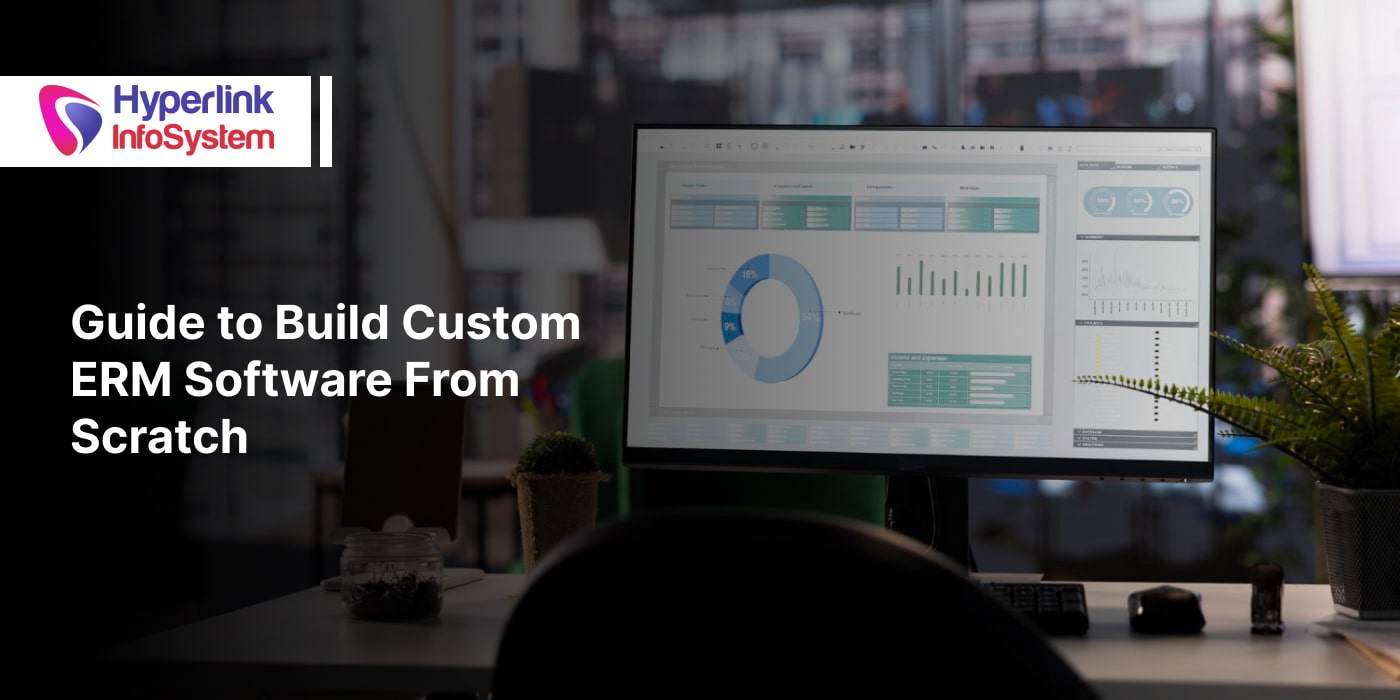Guide to Build Custom ERM Software From Scratch
Nov 2025

Every business faces risks and uncertainties, irrespective of the industry. For most companies, threats include geopolitical factors, cybercrime, regulatory shifts, and fluctuations in the supply chain. Trying to manage these issues using spreadsheets and siloed systems is a waste of time and effort. At the same time, no company can afford to ignore scalability and growth. What is the solution to this pressing issue? Custom ERM software development is the answer.
Whether it's small, medium, or large enterprises, ERM software provides them with a 360-degree view of business risks. With a holistic view of company risks, op management and stakeholders can identify risks early, take proactive measures, and squash them before they turn into threatening problems. The ERM market revenue is expected to grow from $280.49 billion in 2025 to $761.73 billion by 2034. These stats are proof that companies are taking risk management seriously and that ERMs are becoming a standard practice.
Also, we must understand that different departments and individuals may perceive risks differently. A false alarm for one department may be a critical risk for another. Traditional ERM systems may be overly complex or outdated for many. ERM systems establish a standard for risk assessments, ensuring everyone is on the same page. This blog will shed light on building a custom ERM from scratch, its benefits, steps, costs, and more. Let’s get started.
What Is ERM Software?
In simple terms, ERM software is a tool that helps companies identify business risks or issues, assess their potential impact, and develop tailored strategies to address them. A reactive approach is no good for problem-solving. ERM software enables companies to adopt a proactive approach to risk management, staying a step ahead without straying from long-term goals and objectives.
The risk management market $23.7 billion by 2028. Having said that, 75% of organizations admit that their risk management efforts are not enough because of the ever-evolving digital landscape and regulatory environment. Custom ERM software is a blessing for companies because it effectively integrates with compliance management, policy management, audit management, and other software to facilitate informed decision-making.
Most importantly, an ERM software provides a company with a detailed, step-by-step process to manage and mitigate risks. Using data and analytics, the ERM software provides custom strategies to achieve specific business goals. For example, if a healthcare company wants to ensure adequate compliance with a newly introduced law. In this case, the ERM system will analyze where the company stands, whether it is ready to comply with the new law, and how it can meet these standards. Besides ensuring regulatory compliance, ERM software also helps companies avoid costly fines.
The ERM system is more than just an analytics tool. Apart from providing insights, it guides decision makers in a company on how to manage/eliminate risks, work towards company goals, and ensure that processes are aligned towards growth.
8 Reasons to Invest in Custom ERM Software Development
Generic ERM solutions may not work for most companies. Off-the-shelf ERM solutions may seem like a quick fix at first, but over time, they may prove costlier. Per user costs, compulsory upgrades, and sky-high licensing fees may not seem cost-effective in the long run. Also, there are high chances that generic ERM software may pose scalability and data security issues. Below are 8 reasons to invest in custom ERM software development.
- Tailored Risk Frameworks
Every company faces different risks. The risks that a Fintech company faces would be quite different from those of a healthcare organization. For example, a fintech company may face risks such as data privacy, cyber fraud, and market volatility. On the other hand, an automobile company may panic over supply chain disruptions, environmental, or sustainability risks.
With custom ERM software, a company can ensure that it has the necessary tools to address specific needs and manage risks that create hurdles to smooth business operations. No generic solution can match these capabilities.
- Seamless Integration
Most generic or ready-made ERM software is ineffective when integrating with internal, external systems, and third-party apps. Compared to them, a custom ERM software is much better. With custom ERM development services, systems can be programmed to integrate with CRM, HRMS, ERM, and other systems. This seamless integration enables departments to share data without manual intervention.
- Advanced Analytics and Reporting
Unlike off-the-shelf ERM solutions that rely solely on historical data, a custom ERM software with AI and machine learning capabilities identifies key patterns and identifies key risks. This helps companies ensure smooth operations without any hiccups. Whether it is healthcare, manufacturing, finance, or other sectors, businesses can benefit from such a bespoke solution.
Plus, intuitive dashboards allow managers to extract useful data and present it in attractive visual formats to enable informed decision-making. These visuals could be in Excel sheets, charts, graphs, or other formats.
Also, a custom ERM facilitates automatic report generation, saving time and effort. These detailed and accurate reports can be presented to auditing authorities and regulators because of their accuracy.
- Scalability and Flexibility
Over time, the market changes, and so do customer behavior and risk factors. For example, a company may choose to enter a new market, hire new employees, or a governing body may introduce new regulations. Each of these is a risk with varying intensity. Creating new categories, workflows, and processes in the ERM software makes your business ready to manage these risks.
- Stronger Security and Compliance
Every company must implement security measures to protect data, shield against data breaches, and maintain its reputation. Many generic ERM software have pre-configured security measures, but they are not equipped to handle sector-specific challenges. As a result, they are not effective in addressing specific security and ecompliance demands.
Compared to these generic ERMs, developers can tweak custom ERM solutions to incorporate specific security measures such as encryption, security features, and audit trails. By implementing these features, businesses can ensure compliance with regulations and manage risks while aligning with business policies.
- Grand Savings
Many companies make the mistake of settling for a generic ERM software, but it turns out to be expensive in the long run. While a custom ERM may demand upfront investment, it can help companies save money over the course of time. With custom ERM software, companies only have to pay for the features they use, without shelling out licensing fees every year (only a one-time licensing fee).
Custom ERMs are also designed to align with company processes, meaning no more modifications or additional employee training. Finally, companies save thousands to millions of dollars in penalties.
- Enhanced UX
The problem with generic ERM tools is that they are not built with the company’s requirements in mind. Right from the features to the layouts and navigation, none of it matches the company’s requirements. Employees may find it hard to use the software and perform their daily tasks. Conversely, a custom ERM software has a simple dashboard that is tailored to suit industry and user-specific needs.
From admins, managers, department heads, and entry-level employees, everyone will see different features and information (role-specific). Last but not least, the CRM software will mimic the workflows that employees use to perform their day-to-day tasks.
- Competitive Advantage
Risk management means adhering to industry regulations and laws to prevent penalties, but there is more to it than that. Custom ERM software helps companies identify threats and anomalies such as hacking attempts or supply chain disruptions.
At the same time, a custom ERM software guides employees on creating strategies to handle these threats. Even during adversity, ERM systems can detect opportunities that humans may ignore. Companies can explore these opportunities to grab a bigger market share or increase revenue.
9 Steps to Build a Custom ERM Software
Building a custom ERM software requires development companies to think from the client’s perspective. Even if two companies are in the same sector, their risk management needs may be completely different.
Keeping the client’s pain points, risk management culture, regulatory environment, platform choices, architecture, and deployment preferences in mind, the development partner should work on building a custom ERM software. Below are the steps to build a custom ERM software.
1) Understanding the Purpose
Before delving into custom ERM software development, it is important to understand why the client wants the solution. Then it is time to understand the risks that the company faces. Risks could include financial, legal, cyber, and other issues. If the client uses manual tracking to manage risks, they may not be very tech-savvy. Besides developing a custom ERM software, the challenge will also lie in educating the client about how the features work and what they do. The ERM software must also have advanced features like predictive analytics, compliance management, and report generation. This will build trust and confidence.
Apart from the purpose, it is also crucial to know who will use the ERM software. Whether it's risk managers, auditors, or compliance teams, each will use the software differently. The ERM software must be built considering the different needs and requirements of employees while ensuring adequate compliance.
2) Requirement Gathering
When gathering requirements for a custom ERM software, the development company must speak to the stakeholders, including the compliance team, IT staff, and the client’s employees. Everyone will have different needs and expectations. Noting these requirements and expectations would help. Also, the development partner must understand the risks that the company deals with regularly. These risks could include legal hurdles, operational issues, or reputation management concerns.
Understanding these risks and concerns helps the development company create an ERM system that has the necessary features to meet business needs. Furthermore, discussions with different departments and other stakeholders will help categorize risks and develop mechanisms to deal with each one of them. Note that every little detail must be presented on custom dashboards and in simple formats for employees to understand.
3) Creating the Blueprint
As stated above, many parties will use the ERM software, accessing data and tools. Before jumping into actual development, the partner builds a skeletal version of the solution with minimal workflows, features, and functionality. This gives the client an idea of how the custom ERM software will work.
- Data Model
The data model determines what information will go into the system and where. Whether it's risks, incidents, or reports, everything will be in specific locations to ensure smooth and quick access. At the same time, integrating these data repositories with other systems and apps gives the client a comprehensive view of the business.
- User Interface
Different departments and individuals must know where to find information and how to go about their work. The user interface is like an online workspace where users see custom dashboards, features, and organized data. This eliminates clutter, and every user can access relevant data and perform their duties without confusion.
- User Roles
The ERM software must have custom user roles for everyone in the organization. Admins can access anything, including others’ activities, profiles, and data. On the other hand, managers are required to handle daily tasks, auditors need tools and features to ensure compliance, and risk executives need a holistic business view. Each user requires separate user roles to access features and data related to their job role.
- Integrations
ERM software is useless as a standalone system. It must integrate with other systems and apps to work properly. Finance tools, HR systems, customer databases, and other systems must integrate effectively to ensure smooth data flow and reduce manual and repetitive work. The development partner must visualize everything to ensure everything fits together perfectly like a jigsaw puzzle.
4) Choosing the Tech Stack
Choosing the right tech stack for custom ERM software development is critical. The choice of tech stack will determine how the ERM system works in the backend and frontend. Why is this important? It's of utmost importance because different users will interact with the frontend to perform their daily tasks, be it dashboards, forms, reports, and data.
In contrast, the backend is what goes on behind the scenes. The backend includes the engine that powers the ERM software logic, processes data, and lays down the rules for each action. Then comes the database that stores all the data related to risk incidents and compliance-related documents. As users, customers, and data volumes grow, the system must be able to handle these needs. This is where cloud hosting comes into the picture. It helps businesses scale resources and infrastructure as and when required.
Tech stack is also important from a security perspective because data is critical in risk management. Features such as 2-factor authentication, encryption, and role-specific access are crucial. Analytics is also complex because existing tools/platforms, such as Power BI, must integrate with the ERM system. Alternatively, custom dashboards must be provided to each user within the ERM system. The tech stack costs depend on the organization's size. A startup or small firm can manage with a simple system, while a large enterprise will require microservices to handle unique tasks and scenarios.
The typical tech stack for a custom ERM software is as follows:
- Frontend - React, Angular, or Vue.
- Backend - Python (Django/Flask/FastAPI), Java (Spring Boot), or Node.js
- Cloud Hosting - AWS, Azure, and GCP.
- Security - Role-based access, encryption, and 2FA.
- Analytics - Power BI, Tableau, or custom dashboards.
5) Focus on Core Features
Focusing on building core features is crucial when building a custom ERM software. This approach is ideal because it allows development companies to manage everything, while clients can check how every feature works and provide their feedback. Adding too many features, such as AI-powered analytics, integrations, and reports, can increase the time to develop the app. Additionally, users will be overwhelmed with too many features and may become hesitant to explore them.
An experienced development company will start with core features such as report generation and task logging. Once users are comfortable using the new ERM software, they will add premium features such as third-party integrations, analytics, workflow automation, and more. An agile method is best for custom ERM development, wherein development companies focus on features that solve problems. This basic version of the ERM software is called an MVP.
Within a few weeks or months of releasing the MVP, the development team adds new features. The client’s team tests these features and provides feedback. Based on the client’s feedback, the development team will continue to add more features and modules. Such an agile approach to custom ERM software development results in faster and more manageable results.
An example of core features in a custom ERM software would be as follows.
- Authentication and user management
- Risk register
- Risk scoring and heatmap
- Control management
- Incident reporting
- Dashboards and reporting
- Notifications
6) Testing
What use is the ERM software if it does not work the way it is supposed to? Testing ensures that the custom ERM software works as intended. Without stringent testing, the ERM may not perform optimally while dealing with sensitive information or critical tasks like managing compliance, financial risks, and cyber threats. Rigorous testing ensures that the custom ERM software is ready to handle the treacherous waters of the risk management world. Also, it gives users more confidence that they will get the best results.
Development companies conduct testing at various stages. After developers test each feature separately, the QA team conducts exhaustive testing for the entire ERM software while determining its speed, security, and ease of use. Besides real-world testing, development companies also test the software’s limits to check the extent of its abilities.
Then comes the user acceptance testing, where actual users (client’s end) test the ERM software in a controlled environment. This testing phase will tell whether the software is useful and delivers results in real-world scenarios. After so many phases of testing and modifications, the ERM software is ready for deployment.
Below is a summary of the different types of testing for a custom ERM software.
- Functional testing
- User acceptance testing
- Security testing
- Performance testing
7) Deployment
Deployment is the time when the client gets to see if the final output delivers results. Using a product in the development phase is like a boxer practicing his skills on a punching bag. Whereas in the ring, the boxer will have to face a real opponent. Similarly, after development, the ERM software will tackle business-specific challenges. Without proper deployment, ERM software may cause performance issues, security lapses, and even crashes.
To handle such unforeseen problems, development companies usually make proper arrangements to run the ERM solution in proper environments. It can be either on-premises or on scalable, cloud servers. Next, they ensure that the risk and compliance-related data is stored in a secure location, followed by implementing appropriate security measures. Finally, they use CI/CD pipelines to ensure that updates and new versions of the software work smoothly.
8) Training and Adoption
The ERM software is ready, and it has everything to meet business requirements, but sometimes that might not be enough. Often, the custom-built ERM software may face resistance from employees and be hard to understand. Development companies must address this problem by providing practical training sessions to help clients’ staff navigate dashboards, analyze risks, and generate custom reports.
Preparing video tutorials or easy-to-read handbook guides may help with future learning and guidance. Another strategy that many development companies use is releasing the custom ERM software to selected users, such as department heads or risk/compliance teams. After these individuals use the software and provide their feedback, the development team fine-tunes it to align it with their expectations and business needs. Then the company rolls it out to the entire company.
9) Maintenance and Improvements
ERM development, launch, and training are not the end of the story. The ERM software may work smoothly and does not create issues for the client, but it will not remain that way forever. Without proper maintenance, the ERM software may show signs of deteriorating performance, become vulnerable to data breaches, or result in financial losses. The reasons could be many, including coding errors, hardware/software incompatibilities, or third-party dependencies. Regardless, proper maintenance can address the issue.
Furthermore, the development team collects feedback from different teams and employees to obtain insights into which new features must make their way into the ERM software. Monitoring regulatory changes in different sectors is also crucial. Later, the development partner makes the necessary tweaks to the system to ensure adequate compliance. Every update, new build, or release happens only after detailed discussions between the development partner and the client.
Developing custom ERM software from scratch can be challenging for companies with no in-house team or prior experience. It is advisable to partner with a reputed custom software development company for the same.
8 Mistakes to Avoid When Building a Custom ERM Software
Many companies rush through custom ERM software or try to do everything themselves. Such mistakes can eat up a significant part of its budget and destroy employee morale. Below are some of the common mistakes that companies make when building a custom ERM software.
- Neglecting User Needs
Add new features only after consulting key stakeholders such as founders, managers, and department heads.
- Complicated Designs
Focus more on usability than flashy/complicated features.
- Poor Integration Planning
Plan integrations carefully while aligning with existing tools and workflows.
- Weak Data Governance
Establish strong data policies to ensure accuracy, compliance, and governance.
- Lack of Scalability
Invest in a scalable architecture that supports future business growth.
- Poor Security
Implement stringent encryption and access controls to protect data and prevent fines.
- Ignoring Change Management
Handle change management with extensive training and onboarding.
- Lacks Constant Monitoring
Ensure consistent monitoring and timely system updates after deployment.
Interested in developing a custom ERM software for your business? Consider partnering with a top custom ERM software development firm for the best results.
What Is the Cost to Build a Custom ERM Software?
Although the costs to build a custom ERM software depend on many factors, such as app complexity, industry, and features, we will list out the approximate costs to build a custom ERM software.
Costs by Business Size
- Small-sized Businesses - $25,000 - $150,000
- Mid-sized Businesses (with integrations) - $80,000 - $500,000
- Large-Enterprises (AI analytics) - $200,000 - $2M+
Hidden Costs
- Hidden ERM software development costs include migration, training, hardware, licensing, and compliance.
- These costs can be anywhere from $5,000 to $100,000, depending on business needs.
Location-Wise Development Rates
- North America - $100 - $200, can go up to $400
- Western Europe - $70 - $150
- Eastern Europe - $25 - $70
- Latin America - $30 - $60
- India - $18 - $40
- Asia - $18 - $50
These costs are just to give companies a brief idea about custom ERM software development. Consult a custom ERM software development company for detailed guidance and implementation.
Conclusion
Building a custom ERM software from scratch requires a well-thought-out and planned approach. Basically, it boils down to understanding client expectations, adapting to trends, and being future-proof. Development companies must adopt a calculated approach to building custom ERM software by including core features first and adding additional features over time.
At the same time, businesses must understand that embracing new-age ERM software is not optional; it's a necessity, especially for companies in highly regulated industries or that have unique processes. Many companies want to build custom ERM software from scratch, but lack the resources or knowledge to make it happen. Are you one of them? If that is the case, consider teaming up with Hyperlink InfoSystem, one of the leading custom software development companies with a global presence.
Schedule a consultation with our experts to learn more.
Frequently Asked Questions
No, even small and medium-sized enterprises can benefit from large enterprises. The solution is to build custom, lightweight, modular ERM systems with scalability capabilities. Over time, they can add new features to meet business goals.
Hiring custom software is for companies that can afford high development costs. Developers in Europe and North America charge a lot for custom ERM development. Even per-hour costs in Asia can be unaffordable for startups. Hiring custom software developers is only for medium-sized and large enterprises that can bear specialized developer costs.
It is good practice to update ERM systems every 3 months for features. For security patches, monthly updates are recommended.
When an app development company decides to develop an app with premium features suited to meet specific business needs, it must ensure that the client gets the best output. The client pays extra for a premium product. Hiring custom software developers ensures that the client gets value for their money. Below are some of the reasons to hire custom software developers for a project.
- Create a custom app tailored to your business needs
- Scalability and future-proofing
- Seamless integrations
- Saves time and money
- Enhanced security and compliance
- Dedicated support and maintenance
- Competitive advantage
The cost to develop a custom ERM software from scratch depends on many factors, including app complexity, features, integrations, and more. Quoting an approximate figure is tough, but the costs can range from $10,000 to $300,000 or more. It is recommended to consult a reputed ERM app development company for an accurate estimate.
Honestly, the time required to develop a custom ERM software depends on the complexity. A basic ERM can be ready for launch in 3 to 6 months. For complex ERM software, this time could increase to 12 to 18 months.
Latest Blogs

Is BlockChain Technology Worth The H ...
Unfolds The Revolutionary & Versatility Of Blockchain Technology ...


IoT Technology - A Future In Making ...
Everything You Need To Know About IoT Technology ...

Feel Free to Contact Us!
We would be happy to hear from you, please fill in the form below or mail us your requirements on info@hyperlinkinfosystem.com
Hyperlink InfoSystem Bring Transformation For Global Businesses
Starting from listening to your business problems to delivering accurate solutions; we make sure to follow industry-specific standards and combine them with our technical knowledge, development expertise, and extensive research.
4500+
Apps Developed
1200+
Developers
2200+
Websites Designed
140+
Games Developed
120+
AI & IoT Solutions
2700+
Happy Clients
120+
Salesforce Solutions

40+
Data Science

















